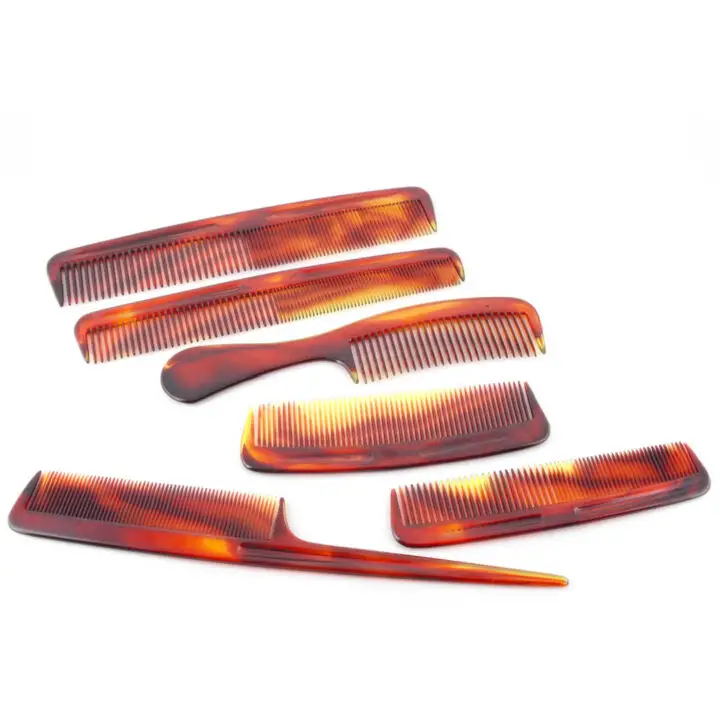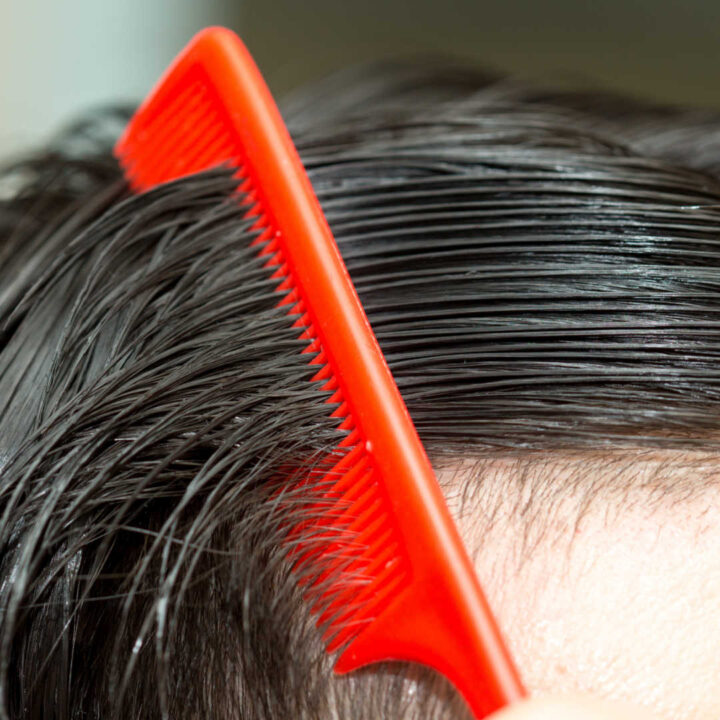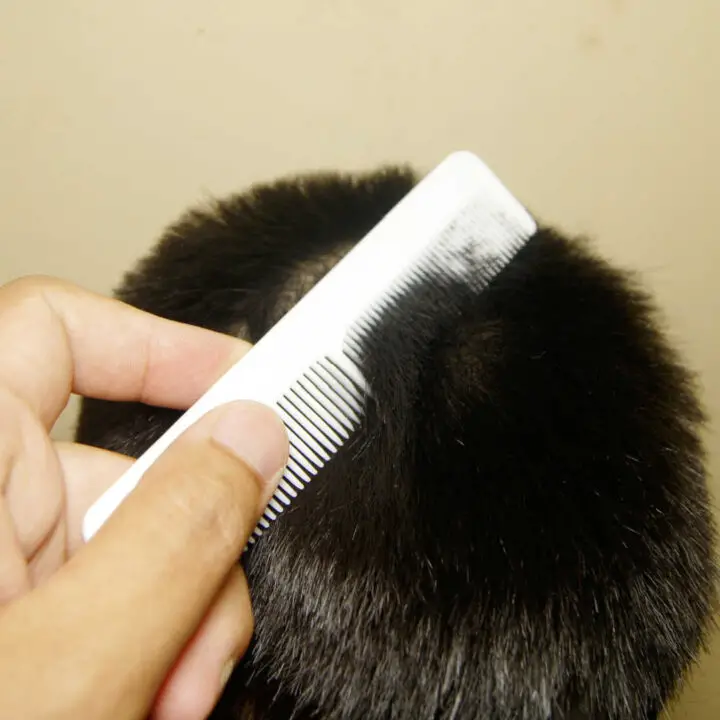
It might seem obvious, but finding the right way to comb your hair can actually be a puzzle for some men. Believe it or not, something as simple as choosing the correct comb can have an impact on your hair’s health and style. This guide breaks down techniques and tools that will transform your daily grooming routine, turning hair mishaps into perfection.
[Ed. Note: Amazon links for examples and are affiliate. However you should be able to readily find these types of products locally.]
Key Takeaways
- Choose the correct comb for your hair type, such as a wide-tooth comb for thick or curly hair and a fine-toothed one for straight hair to prevent damage.
- Be gentle when detangling, start from the ends moving towards the roots, use conditioner to ease knots, and avoid pulling which can lead to breakage.
- Combing before shampooing can distribute natural oils throughout your hair, and using a comb through conditioner helps evenly spread it out.
- Use appropriate combs or brushes depending on your hairstyle needs—combs are better for detangling and brushes are great for smoothing out styles.
- Different hair lengths from short to long require varying techniques; use light strokes for short cuts and work from ends up with longer locks.
The Importance of Properly Combing Your Hair
Properly combing your hair is good for maintaining its health and appearance. It involves choosing the right comb, being gentle to avoid damage, and detangling before shampooing or conditioning. Different hair types require different techniques to ensure proper care.
Choosing The Right Comb

Selecting an appropriate comb can make a significant difference in haircare and styling. For those with thick or curly hair, a wide-toothed comb helps detangle without pulling or breaking strands, preserving the natural curl pattern.
Meanwhile, fine-toothed combs work best for straight hair to achieve sleek side parts and precise styles. Materials also matter—a wooden comb reduces static and frizz compared to its plastic counterpart.
Consider your styling needs as well; if volume is your aim, choose a round comb to lift hair at the roots while blow drying. Always ensure that the teeth of the comb are smooth to avoid snagging and damaging the hair shafts.
Balancing function with gentleness will not only keep your hairstyle sharp but also maintain healthy locks over time.
Being Gentle
Treating your hair with care when combing is as important as choosing the right outfit for an interview. Begin at the tips and gently work your way to the roots to avoid yanking or pulling, which can lead to breakage and split ends.
A wide-tooth comb plays a key role here, especially if you’re dealing with knots in long hair or after sleeping on damp locks. Gentle strokes help maintain hair health and prevent unwanted frizzes that could sabotage your style.
Using patience while detangling is non-negotiable; it’s like slowly unraveling a knotted necklace chain. Rushing through this process can not only damage your hair but also turn what should be a simple grooming routine into a frustrating battle against tangles.
Especially for those with thicker, curly types of hair, starting from the ends allows natural oils to glide along each strand, reducing snags and promoting overall smoother styling experiences without relying too heavily on products like pomade or mousse.
Combing Before Shampooing

Combing before shampooing does more than just detangle your hair; it helps spread natural oils from the scalp throughout the strands. This essential step boosts shine and health, setting the stage for cleaner, more manageable hair post-wash.
It also preps your locks for a thorough cleanse by loosening any dirt or product build-up. As you comb, you’re not only arranging your hair but also stimulating the scalp which promotes healthy growth—think of it as a mini massage that readies your head for refreshing nourishment.
Ensuring that your mane is free of knots before adding shampoo minimizes breakage and makes conditioning even more effective afterward. Combs glide through conditioner-soaked hair with greater ease, laying down a smooth path toward ultimate style and volume control in thick or short hair alike.
After addressing why to comb prior to shampooing, let’s consider how to maintain silky strands with conditioner as our ally.
Comb-Through Conditioner
Before moving on to the next step in your hair care routine, understand the benefits of combing through conditioner. This technique is essential for evenly distributing the conditioning product throughout your hair, ensuring that every strand receives the nourishment it needs for a healthy and stylish look.
By combing through conditioner, you can effectively detangle your hair while also maximizing the benefits of the product, leaving your locks smooth, manageable, and well-nourished.
Conditioner plays a crucial role in maintaining healthy and styled hair. Combing through it after application helps ensure thorough coverage and provides an opportunity to gently detangle any knots or snarls without causing damage.
Detangling Hair
To detangle hair effectively, start by using a wide-tooth comb or a specialized detangling brush, which helps to minimize breakage and discomfort. Gently work through the ends of the hair first before moving upward towards the roots, tackling any knots or tangles as you go.
Additionally, it’s crucial to comb through wet hair after applying conditioner, allowing the product to evenly coat each strand and making detangling smoother and more manageable.
Choosing the right tools and being gentle while detangling are essential steps in maintaining healthy-looking hair. By incorporating these tips into your grooming routine, you can ensure that your hair stays smooth, free from tangles, and looking its best every day.
How to Properly Comb Different Hair Types

Whether you have straight, wavy, curly, or coarse hair, the way you comb your hair can make a big difference in how it looks and feels. Each type of hair requires a different approach to achieve the best results, so it’s important to understand the right techniques for your specific hair type.
Straight
To properly comb straight hair, start by choosing a wide-tooth comb to gently detangle the hair without causing breakage. This is to maintain the smoothness and sleek look of straight hair.
Additionally, using a paddle brush can help add volume and shape to straight hair, providing a polished and put-together appearance.
Wavy
Wavy hair has unique wave-like patterns that require proper care and styling techniques. It’s important for men with wavy hair to use the right hairbrush and technique to maintain their waves without causing breakage or split ends.
By using a natural bristle brush and anti-static hair products, individuals can prevent static, a common issue for those with wavy hair. Additionally, regular brushing not only helps distribute natural oils but also assists in reducing dandruff by removing dead skin cells and keeping the scalp healthy.
Curly (with large curls)
To properly comb curly hair with large curls, start by using a wide-tooth comb or a detangling brush to gently work through the hair, starting from the ends and working your way up to the roots.
Use conditioner to add slip and moisture before combing to minimize breakage and friction. It’s crucial to detangle while the hair is still wet or damp, as this helps reduce frizz and makes it easier to style.
Be patient when detangling large curls, taking small sections at a time and avoiding pulling or tugging on knots.
When styling curly hair with large curls, consider using products specifically designed for this hair type, such as curl-enhancing creams or gels. These can help define curls while reducing frizz and adding volume.
Curly (with tight curls)
To properly comb curly hair with tight curls, select a wide-tooth comb to minimize breakage and maintain the natural curl pattern. Gently detangle the hair starting from the ends and working your way up to avoid causing damage or frizz.
Apply a leave-in conditioner to add moisture and keep the curls defined. When styling, consider using products specially formulated for curly hair such as curl-enhancing creams or gels to control frizz and enhance definition.
Regularly moisturizing tight curls is crucial in keeping them healthy and manageable. Deep conditioning treatments can also help nourish the hair, reducing tangles and making it easier to comb through.
Coarse (kinky)

Coarse (kinky) hair demands extra care to maintain its natural texture and prevent frizz. When detangling, opt for a wide-tooth comb to minimize breakage and preserve the hair’s integrity.
Regularly moisturize with a leave-in conditioner or oil to keep the coils defined and manageable. Avoid over-brushing, as this can lead to excessive frizz and disrupt the hair’s pattern.
Ensure that your styling products are specifically tailored for coarse (kinky) hair, offering moisture and hydration without weighing the strands down. Embrace protective hairstyles to shield the hair from environmental stressors and reduce manipulation, promoting healthy growth.
Techniques for Combing Different Hair Lengths
When it comes to different hair lengths, the techniques for combing can vary. Short hair may require light and quick strokes, while medium to long hair may benefit from sectioning and carefully working through tangles.
Short
For short hair, using a fine-toothed comb can help create sleek and polished looks. Gently comb the hair in the direction you want it to lay, and use styling products as needed to hold the shape.
Keep in mind that shorter styles may require more frequent trims to maintain their shape and clean lines.
Medium
For medium hair lengths, a combination of a wide-tooth comb and a boar bristle brush works best. Start by using the wide-tooth comb to detangle any knots, working from the ends up to prevent breakage.
Then, follow up with a boar bristle brush to distribute natural oils from the scalp down to the ends for added shine and smoothness. It’s essential to avoid over-brushing that can create frizz, especially for those with wavy or curly medium-length hair.
When dealing with medium-length hair, don’t tug or pull too hard on stubborn tangles as this can cause damage. Moving gently through each section will help minimize breakage and promote healthy-looking locks without unnecessary stress on your strands.
Long
For long hair, start combing from the ends and work your way up to prevent breakage. Using a wide-tooth comb is ideal for detangling and reducing damage. Additionally, incorporating regular trims can help maintain the health and manageability of long hair, preventing split ends and promoting overall hair growth.
When conditioning long hair, focus on applying the product to the mid-lengths and ends. This helps keep the scalp from becoming too oily while providing adequate moisture where it’s needed most.
Regular brushing also aids in distributing natural oils along the length of your locks, keeping them healthy, shiny, and less prone to breakage.
The Difference Between Combs and Hair Brushes
Combs and hairbrushes serve different purposes for hair care. Understanding the benefits of each tool can help you choose the right one for your hair type and styling needs. Whether it’s detangling, adding volume, or shaping your hairstyle, knowing when to use a comb versus a brush can make a significant difference in achieving your desired look.
When To Use One Over The Other
Combs are ideal for detangling and styling hair, especially for those with thick or curly hair. They help to separate strands without causing breakage, making them a great choice for achieving volume and defining curls.
On the other hand, brushes are better suited for distributing oils from the scalp to the ends of the hair, as well as smoothing and styling straight or wavy hair. Brushes can also be used to create sleek looks or blend different sections of styled hair.
Considering your specific hair type and desired hairstyle will guide you in choosing between a comb and a brush when styling your hair. The decision should align with your goals – whether detangling, adding volume, defining curls, smoothing out waves, or creating sleek straight styles.
Conclusion
To properly comb your hair, choose the right comb for your hair type. Be gentle when combing to avoid breakage and damage. Always detangle your hair before shampooing or conditioning.
Comb-through conditioner can help manage knots and tangles effortlessly. Remember to use different techniques for straight, wavy, curly, and coarse hair types while combing. Different types of hair length require specific techniques for optimal results.
Using the right tools and proper techniques will ensure healthy, well-styled hair every time.
